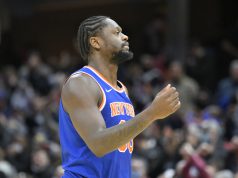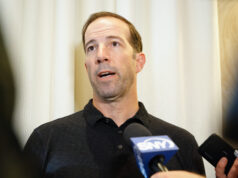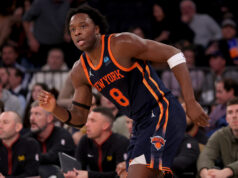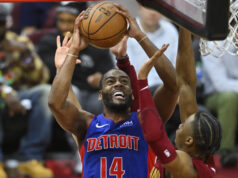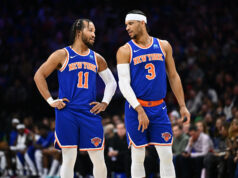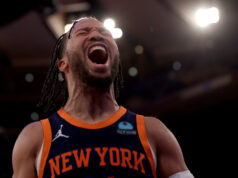On May 3, 2013, the New York Knicks defeated the Boston Celtics, 88-80, to advance to the Eastern Conference semifinals in 6 games. Now, the two are in vastly different situations.
Despite a furious Boston comeback, the Knicks were able to close out the Celtics on the road and win the series in six games, their first playoff series win in a decade.
At that point, the Knicks and the Celtics looked like two organizations trending in completely different directions. Boston, on the one hand, was a year removed from almost knocking off LeBron James and the mighty Miami Heat in the Eastern Conference Finals. However, a lackluster 2013 season saw the Celtics finish 7th in the East before an untimely first round exit.
Ray Allen had jumped ship to Miami. Paul Pierce and Kevin Garnett began to run out of juice. Rajon Rondo, their inspiration the previous season, was out due to a torn ACL.
The Celtics had the look of a has-been team whose best days were behind them.
The Knicks, on the other hand, were flying high on the back of a division winning, 50 win season that saw them finish second in the Eastern Conference. Carmelo Anthony led the league in scoring, J.R. Smith won Sixth Man of the Year and Tyson Chandler was a defensive anchor. The team shot and made a ton of threes, played fierce defense and was a joy to watch on a nightly basis.
As they prepared to duel with the Indiana Pacers in the Eastern Conference semifinals with home court advantage, the consensus was the Knicks’ best days were ahead of them despite an aging core.
Fast forward four years and the writing on the wall in 2013 could not have been more incorrect. The Celtics are fresh off arguably one of the best two-day stretches in their history, winning Game 7 of the Eastern Conference Semifinals against the Wizards on Monday night before winning the draft lottery on Tuesday, courtesy of a swap with the Brooklyn Nets.
The Knicks, meanwhile, dropped from 7th to 8th overall in the lottery, after another subpar season where they barely eclipsed 30 wins. The Celtics are the top seed in the East and doing battle with the Cleveland Cavaliers in the Eastern Conference Final. Oh, and they have the number one pick in the most loaded draft in a decade.
How did this happen? How did the Knicks, who were trending upward, collapse so dramatically? How did the Celtics, who looked like a dying dynasty, retool and return to prominence so quickly?
It’s a story of two franchises run differently; a story of how patience is a virtue, impulsivity a sin and how one trade combined with one lucky bounce of ping pong balls can determine the balance of power across the NBA landscape.
It all started in the summer of 2013. The Celtics, licking their wounds after a painful first round exit, decided it was time to retool completely. The Knicks, following a second round exit at the hands of the Indiana Pacers, also decided changes were needed to inject some much-needed youth into an aging franchise.
The Celtics made a draft day trade for the ages. They shipped off franchise legends Paul Pierce and Kevin Garnett, along with Jason Terry, to the Brooklyn Nets, for an assortment of spare parts, expiring contracts and draft picks. Boston got Brooklyn’s first rounders in 2016 and 2018, as well as a pick swap in 2017. Keep these draft picks in mind as we proceed.
The Celtics also shipped head coach Doc Rivers to the Los Angeles Clippers and signed Brad Stevens, best known for leading the Butler Bulldogs to back-to-back NCAA National Championship Games.
The Knicks, rather than keeping first round picks, discarded them to Toronto, along with Steve Novak and Marcus Camby, for Italian big man and former first overall pick Andrea Bargnani. The stretch-five was widely considered a bust or at least a player that never lived up to the hype, but the Knicks brass viewed him as a valuable asset nonetheless.
Heading into the 2013-14 season, the Knicks and Celtics remained two teams trending in opposite directions. The Celtics got Rondo back from injury, but still had a feeble roster and looked destined for the lottery. The Knicks, on the other hand, returned most of their core players, including a freshly re-signed J.R. Smith, and Carmelo Anthony in a contract year.
To be fair, the Celtics played the part. Boston amassed a record of 25-57, good for 4th in the Atlantic Division and 12th in the Eastern Conference, and secured a top ten pick. Their top three scorers that season: Jeff Green, Avery Bradley and Jordan Crawford.
The Knicks, on the other hand, took a massive step back. Carmelo and Tyson Chandler struggled to play to the levels of the year before. J.R. Smith completely tanked, first round pick Tim Hardaway Jr. did not live up to expectations and head coach Mike Woodson lost control of the team. The Knicks went 37-45, finished with 17 fewer wins than the season before and missed the postseason by one game.
The Knicks were now in a tricky position. While Boston was very committed to rebuilding, the Knicks had a lack of assets and an aging team that failed to mesh the season before. Changes were needed, and new President of Basketball Operations Phil Jackson pulled the trigger, trading Tyson Chandler back to Dallas for Jose Calderon.
Boston, meanwhile, used their lottery pick to draft combo guard Marcus Smart out of Oklahoma State.
During the regular season, the Celtics made two terrific trades, acquiring Isaiah Thomas from Phoenix and Jae Crowder from Dallas. Both of them became key contributors to a Celtics team that exceeded all expectations — going 40-42 and making the postseason as the 7th seed in the East. Despite getting swept by LeBron and the Cavaliers, the fact that the Celtics had returned to the playoffs just two years after “tearing it down” was more than encouraging.
The Knicks, meanwhile, had their worst season in franchise history. A poor start saw Jackson trade J.R. Smith and Iman Shumpert to Cleveland, and shelf Carmelo for the second half of the season due to injury. The Knicks trotted out a team of D-League misfits and went 17-65 as a result, good for the worst record in the Eastern Conference. In just two years, the Knicks went from title contenders to the cellar of the NBA.
Things looked like they had gotten worse when the Knicks dropped from 2nd to 4th in the draft lottery and missed out on Karl-Anthony Towns, Jahlil Okafor and D’Angelo Russell. However, selecting Kristaps Porzingis turned out to be the lone bright spot since the 2013 season for the Knicks — the Latvian big man has already turned out better than Okafor and Russell, and looks like a future All-Star.
Phil Jackson tried to rebuild on the fly on the heels of the draft and signed free agents Arron Afflalo, Robin Lopez, Kyle O’Quinn and Derrick Williams to add to the Porzingis-Carmelo duo.
Boston, on the other hand, only added Amir Johnson in free agency, as well as Terry Rozier in the NBA Draft.
Again, the Celtics were the superior team, gleefully watching Brooklyn tank their way to the 3rd spot in the draft, while racking up 48 wins and finishing with the 5th best record in the East. The Knicks, despite a strong start, again failed to make the playoffs and went 32-50, 13th in the East. They also lost their draft pick courtesy of the Andrea Bargnani trade that resulted in zero playoff appearances.
The current state we’re at — The Celtics deep playoff run and the Knicks somehow finding a way to make the tail end of the lottery — came to a head in the summer of 2016. Again, Phil Jackson tried to rebuild quickly, flipping Robin Lopez and Jerian Grant to Chicago for Derrick Rose, and signing Joakim Noah and Courtney Lee to lucrative multiyear deals.
[graphiq id=”2SpPKJohOND” title=”Boston Celtics at New York Knicks” width=”600″ height=”729″ url=”https://sw.graphiq.com/w/2SpPKJohOND” frozen=”true”]The Celtics picked Jaylen Brown third overall, courtesy of those pesky Brooklyn Nets, and signed All-Star center Al Horford to a multiyear deal to pair with Isaiah Thomas, who made the All-Star game the season before.
The rest you can figure out: Thomas became a superstar, especially in the fourth quarter. Horford and Boston’s seemingly unending plethora of assets was enough to back Thomas and lead Boston to the best record in the conference.
The Knicks, meanwhile, sucked again. Carmelo Anthony and Phil Jackson publicly fell out. Derrick Rose failed to show up for a game and tell the team. Porzingis regressed due to the team using him incorrectly. Noah’s contract is probably the worst one of the last decade in the NBA and the Knicks still failed to capitalize on their poor record, winning a meaningless Game 82 vs. the 76ers, which tied them record-wise with the Timberwolves, which led to them losing a coin flip, which gave them the 7th best odds of the top pick, which still wasn’t enough as they fell to the 8th pick in a draft that is widely considered to have seven top caliber players.
The Celtics, however, won the lottery thanks to the Nets, and now have the top pick in a stacked draft.
A string of bad trades and a lack of patience to rebuild has the Knicks in a position where they want to offload their depreciating franchise player, as well as get rid of Noah’s unmovable contract. They also have hit an all time low with front office turmoil, and nobody thinks Jeff Hornacek is the guy at head coach.
RELATED: The Knicks' Latest Mock Draft
Boston, meanwhile, is gearing up for the Eastern Conference Finals. They have two-star caliber guys in Thomas and Horford, five genuinely terrific role players/assets in Crowder, Jaylen Brown, Avery Bradley, Marcus Smart, and Terry Rozier, and one of the brightest coaching minds in the NBA in Brad Stevens.
Oh, and they have the number one pick. And they have Brooklyn’s top pick next year as well.
Four years ago, the Knicks were trending upwards, and the Celtics were trending downwards. Four years later, not only have the roles reversed, but the NBA community has been treated to two valuable lessons: how to reconstruct a team, and how not to.




